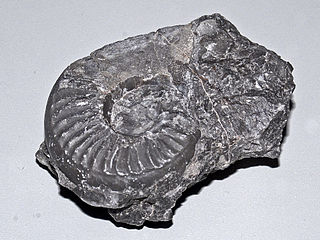
Cooperoceras is a genus of Tainoceratid nautiloid cephalopod molluscs within the superfamily Tainoceratoidea, characterized by and evolute shell with an open, perforate, umbilicus, sinuous ribs at maturity, and recurved hollow spines along the ventro-lateral shoulders. The flanks and venter are flattened, the flanks converge on the dorsum, the venter has a shallow median groove. The suture is with rounded ventral and lateral lobes. The siphuncle is small, tubular, and subcentral.
Tetragonoceras is an extinct prehistoric nautiloid genus from the nautilid family Tetragonoceratidae that lived during the Middle Devonian, found in Canada.
Sholakoceras is an extinct genus of nautiloid cephalopods from the Lower Permian of southern Russia, included in the Tainoceratacean family Rhiphaeoceratidae,. The shell of Shalakoceras is evolute with a perforate umbilicus. Whorl sections are subquadrate with the ventral and lateral sides flattened and ventral and umbilical shoulders rounded. Lateral areas bear short, slightly oblique ribs. sutures form broad ventral saddles with a slight, shallow lobe, very shallow lateral lobes, and a deep funnel-shaped dorsal lobe.
Strophiceras is an extinct genus of cephalopods from the Order Nautilida, which includes, in a separate family, Nautilus and Allonautilus.
Homaloceras is an extinct nautiloid cephalopod from the Middle Devonian with a strongly curved shell, included in the nautilid family Centroceratidae.
Permoceras, the sole member of the family Permoceratidae, is a genus of coiled nautiloids with a smooth, compressed involute shell, whorls higher than wide, earlier whorls hidden from view. The venter is rounded as are the ventral and umbilical shoulders, the flanks flattened. The siphuncle is ventrally subcentral. The suture, which is most characteristic, has a deep, narrow pointed ventral lobe and large, asymmetrical pointed lobes on either side.
Jovellania is a genus of extinct prehistoric nautiloids from the order Oncocerida known from the Lower Devonian of Europe. Nautiloids form a broad group of shelled cephalopods that were once diverse and numerous but are now represented by only a handful of species in two genera.
Endolobus is an extinct genus from the nautiloid order, Nautilida. Nautiloids are a subclass of shelled cephalopods that were once diverse and numerous but are now represented by only a handful of species, including Nautilus. Endolubus is included in the family Koninckioceratidae which is part of the superfamily Tainoceratoidea.
Permonautilus is an extinct genus of nautilids from the Upper Permian of Russia, named and described by Kruglov in 1933. Permonautilus is an involute, globular, spinose member of the Lirocertidae which are included in the Clydonautilaceae. Whorl sections are broad, with a rounded venter. The umbilicus in the middle of the shell is deep, from which spine-like processes extend laterally in the mature portion near the aperture. The siphuncle in Permonautilus is subcentral, the suture, slightly sinuous.
Tetrapleuroceras is an extinct prehistoric nautiloid from the Lower Permian of the Urals in Russia. Nautilids are a type of nautiloid, a subclass of shelled cephalopods that were once diverse and numerous but now only represented by Nautilus and Allonautilus
Tithonoceras is a genus of nautiloid cephalopod from the Upper Jurassic found in the Crimea, belonging to the nautilacean family Paracenoceratidae.

Titanoceras is an extinct genus in the nautiloid order Nautilida from the Pennsylvanian and Lower Permian of North America and Western Australia.
Tylonautilus is an extinct genus in the nautiloid order Nautilida from the Lower Carboniferous of Europe and Permian of Japan.
Heminautilus is an extinct genus of nautiloids from the nautilacean family Cenoceratidae that lived during the Early Cretaceous. Fossils of Heminautilus have been registered in rocks of Barremian and Aptian age. Nautiloids are a subclass of shelled cephalopods that were once diverse and numerous but are now represented by only a handful of species.
Stearoceras is an extinct genus of prehistoric nautiloids from the Lower Pennsylvanian - Lower Permian with a fair worldwide distribution.(Kümmel 1964)
Triboloceras is the name given to an extinct nautiloid genus from the Lower Carboniferous (Mississippian), included in the nautilid family Trigonoceratidae characterized by an evolute shell bearing longitudinal ribs, with whorls in contact except in the early and very latest growth stages. Chambers are short, sutures tend for form ventral and in some cases dorsal and lateral lobes. The siphuncle is small, tubular, and subcentral.
Trigonoceras is an extinct genus of prehistoric nautiloids from the nautilid family Trigonoceratidae that lived during the Early Carboniferous in what is now western Europe.
The Trigonoceratidae is a family of coiled nautiloid cephalopods that lived during the period from the Early Carboniferous (Mississippian) to the Early Permian.
The Centroceratidae is the ancestral family of the Trigonoceratoidea and of the equivalent Centroceratina; extinct shelled cephalopods belonging to the order Nautilida

Pleuronautilus is a nautiloid genus; family Tainoceratidae, order Nautilida.


